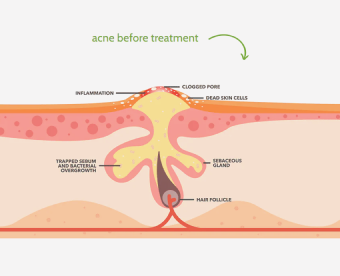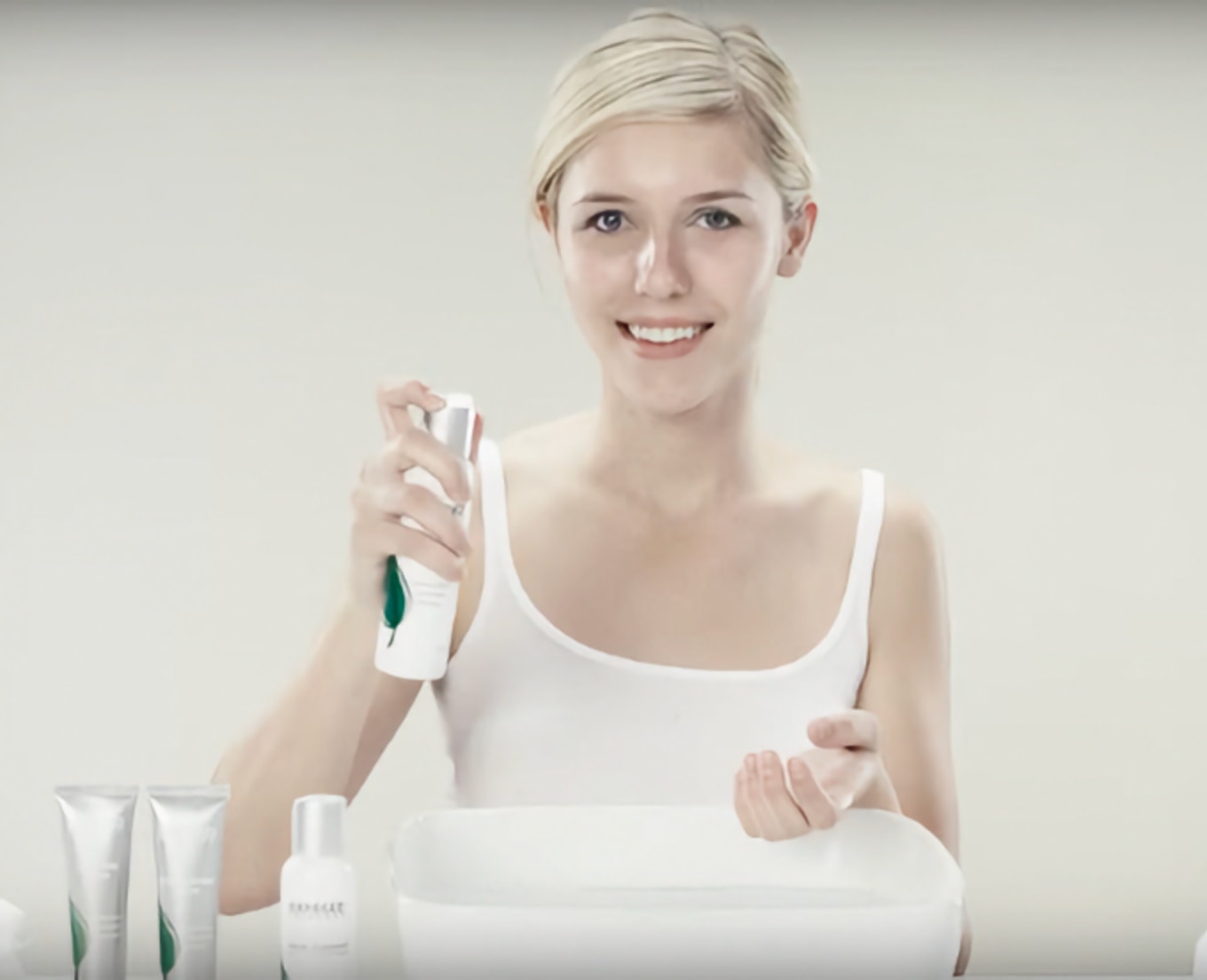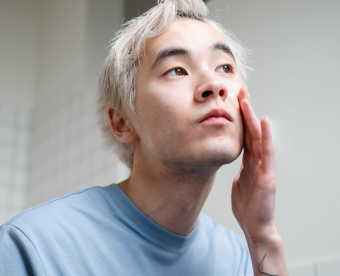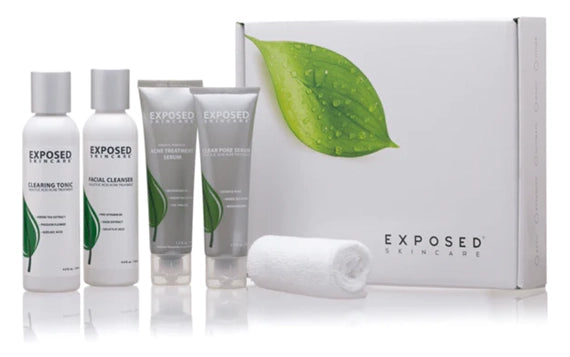During winter, your skin can react to cold weather by producing excess oil, leading to unexpected breakouts. To manage winter acne, start with a gentle cleanser that won't strip your skin's natural moisture, followed by a non-comedogenic moisturizer to maintain hydration. Exposed Skin Care's moisturizer provides deep hydration while helping to calm irritation, making it an excellent choice for winter skincare.
Exfoliate 1-2 times weekly with salicylic acid, and always apply broad-spectrum SPF 30, even on cloudy days. Use a humidifier to combat dry indoor air, and opt for lukewarm showers to preserve your skin barrier. Consider incorporating omega-3 rich foods and antioxidants into your diet for enhanced skin support. Understanding these seasonal adjustments will help you develop an effective winter skincare strategy.
Also read: How to choose the best acne treatment
Biggest Takeaways
-
Use a gentle cleanser and non-comedogenic moisturizer like our Moisture Complex to maintain skin hydration without clogging pores during dry winter months.
-
Combat indoor heating effects with a humidifier and lukewarm showers to prevent excess oil production and skin barrier damage.
-
Apply broad-spectrum SPF 30 daily and layer moisturizing products, starting with lightweight gels and finishing with protective creams.
-
Exfoliate 1-2 times weekly with salicylic acid to prevent dead skin buildup while avoiding over-stripping natural oils.
-
Incorporate antioxidant-rich foods and omega-3 fatty acids into your diet while maintaining proper hydration for skin health.
- The Exposed Skin Care Treatment Kit provides a complete solution for winter acne, combining gentle cleansing, targeted treatments, and skin-friendly hydration to effectively manage breakouts without causing dryness.

Understanding Winter Acne Triggers
While many people blame their winter breakouts on cold weather alone, several interconnected factors contribute to seasonal acne flare-ups.
When environmental factors like low humidity and indoor heating strip moisture from the air, your skin compensates by producing excess oil.
You're not alone if you've noticed that hot showers and heavy skincare products make things worse - they can further compromise your skin barrier.
If you're dealing with winter acne, you should know that even those without typically acne-prone skin may experience breakouts during colder months.
Your skin's protective barrier weakens, making it more vulnerable to bacteria and inflammation.
Additionally, seasonal stress and holiday dietary changes can trigger hormonal fluctuations that lead to those frustrating winter breakouts.
Essential Winter Skincare Steps
When winter weather strikes, maintaining a consistent skincare routine becomes essential for managing acne breakouts. Start by switching to a gentle cleanser that won't strip your skin's natural moisture barrier.
Follow up with a non-comedogenic moisturizer to lock in hydration while keeping pores clear. You'll want to exfoliate once or twice weekly using products with salicylic acid to remove dead skin cells and prevent clogged pores.
For extra protection against dry skin, layer your acne-fighting products strategically. Apply a lightweight moisturizer first, then seal it in with an occlusive agent at night.
Don't skip the sunscreen - even in winter, UV rays can worsen acne and damage your skin, so apply a broad-spectrum SPF 30 daily as your final morning step.

Exposed Skin Care Treatment Kit
The Exposed Skin Care Treatment Kit offers an extensive solution for managing winter acne breakouts.
You'll find everything you need in this thorough system, from a gentle cleansing wash to targeted acne treatment and skin-friendly moisturizer. The powerful combination of salicylic acid and benzoyl peroxide works effectively on acne-prone areas while maintaining essential skin hydration during harsh winter months.
What makes this kit particularly appealing is its non-irritating formulations, designed to combat breakouts without causing excessive dryness.
You'll appreciate the straightforward, step-by-step skincare routine that's easy to follow and maintain. Many users like you have reported noticeable improvements in their skin's clarity and texture within weeks of consistent use, making it a reliable choice for managing winter acne while keeping your skin balanced and healthy.
Moisturizing for Acne-Prone Skin
Maintaining proper hydration remains essential for acne-prone skin during winter, even if you're worried about making breakouts worse. Your skin needs moisture to prevent excessive oil production, which can trigger new breakouts when it's cold outside.
You'll want to choose a non-comedogenic moisturizer containing ingredients like hyaluronic acid that won't clog your pores. Apply it right after using your cleanser while your skin is still damp to lock in moisture effectively.
During winter, you might need to increase your frequency of moisturizing, especially if you're using acne treatments. Try layering products - start with a lightweight gel, then follow with a heavier cream if needed.
This approach helps you maintain ideal hydration while keeping your skin balanced and clear throughout the colder months.
Daily Winter Protection Routine
Protecting acne-prone skin during winter requires a strategic daily approach that balances cleansing and hydration.
Your daily skincare routine should start with a gentle cleanser that won't strip away natural oils, followed by a non-comedogenic moisturizer to lock in hydration. Don't forget to apply broad-spectrum sunscreen before heading outdoors, even on cloudy days.
Combat dry indoor air by running a humidifier while you're at home or sleeping. You'll notice your skin retains moisture better, which helps prevent winter acne flare-ups.
When showering, resist the temptation to stay under hot water too long - stick to lukewarm temperatures for five minutes or less. This way, you're maintaining cleanliness while preserving your skin's protective barrier, making your acne fighting products more effective.
Managing Cold Weather Breakouts
Winter weather can trigger unexpected breakouts, even if you're following a solid protection routine. When cold weather hits, your skin's response to dropping humidity levels can lead to excess oil production and increased acne. You're not alone in this seasonal struggle – many people face similar challenges during winter months.
| Trigger | Solution |
|---|---|
| Dry Air | Use humidifier at home |
| Indoor Heat | Apply non-comedogenic moisturizers |
| Layered Clothing | Choose breathable fabrics |
| Diet Changes | Monitor comfort food intake |
To manage breakouts effectively, focus on maintaining your skin's moisture balance without over-drying. While it's tempting to combat excess oil with harsh treatments, gentle skincare approaches often work better. If you're experiencing severe winter acne, don't hesitate to seek professional medical advice for personalized treatment options.
Winter Diet and Skin Health

While the cold season brings comfort food cravings, your diet choices can greatly impact your skin's health during winter months. You'll want to focus on foods rich in antioxidants and omega-3 fatty acids, which help combat inflammation and reduce acne flare-ups.
Load your winter diet with colorful fruits and vegetables, along with fish, walnuts, and flaxseeds to maintain a healthy skin barrier.
Watch out for those holiday treats, though! High sugar and dairy consumption can trigger breakouts by increasing inflammation. Instead, prioritize foods packed with vitamins A, C, and E, like carrots, citrus fruits, and nuts, to support your skin's natural repair processes.
Don't forget about hydration - drinking plenty of water is essential for maintaining skin elasticity and preventing winter-related irritation.
Putting It All Together
You've now got all the tools needed to combat winter acne effectively. By following a consistent skincare routine, protecting your skin from harsh weather, and maintaining proper hydration, you'll keep breakouts at bay during the cold months. Remember to adjust your diet and treatments as needed. With these strategies, you can maintain clear, healthy skin throughout winter.


















